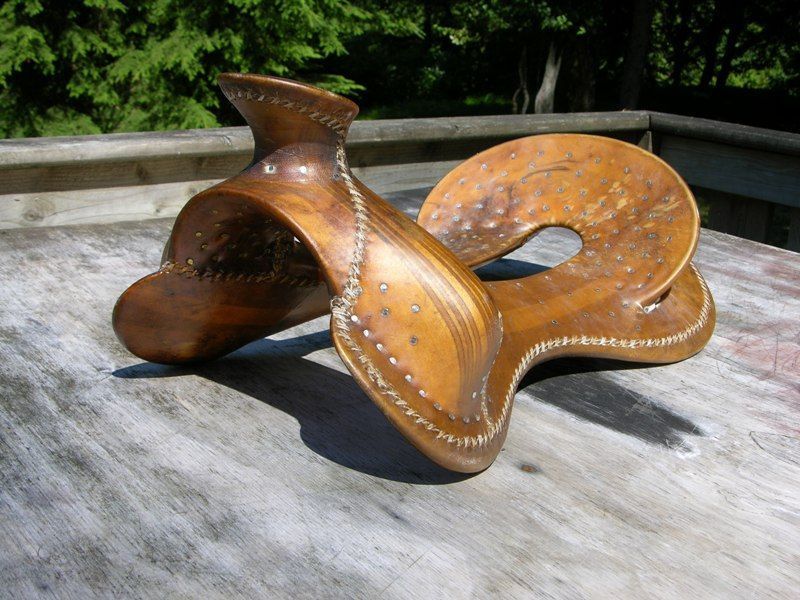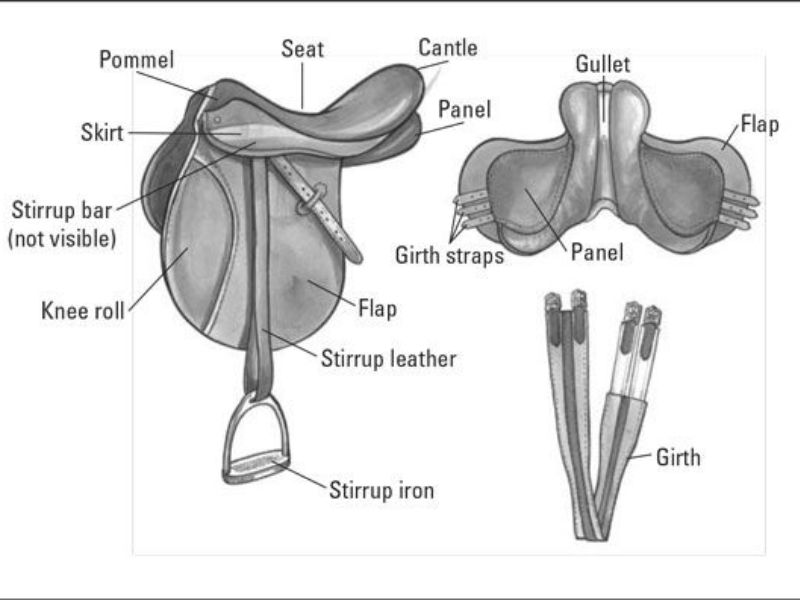Saddle tree is the rigid frame which works as the foundation that holds the entire structure of the saddle. It is the main skeleton of the saddle which provides support to both the rider and the horse.
By distributing their weight, it prevents riders from putting unnecessary pressure on the horse’s spine. It is mostly made from wood, synthetic materials, fiberglass, or carbon fiber. A well-built tree ensures that the weight is distributed evenly across the back.
A wood tree gives a steady, familiar feel, while synthetic trees are easier to maintain. Some trees also come with the option of wood combined with fiberglass or carbon fiber, which provides the benefits of both styles.
To choose the right saddle type according to your needs, it’s important to understand the plural forms and variations of saddle trees.
What Is a Saddle Tree?
The saddle tree is the skeleton that shapes and holds the saddle together. It is a rigid frame that works as the foundation and structure of the saddle. Its main role is to distribute the rider’s weight evenly across the horse’s back.
It is usually made from wood or synthetic materials like fiberglass or carbon fiber, but the purpose and function of both are the same. The saddle tree includes some key parts like the pommel (at the front), the cantle (at the back), and two long bars (running across the horse’s sides). There is a gullet between these bars that works as a channel to leave space for the spine.
For flexibility and durability, you need the right shape and dimensions of these saddles according to your horse. Saddle fitting is an important factor that reduces discomfort and the risk of injury.
Types of Saddle Trees
Wooden Trees
Wood is a traditional material used for centuries because it is strong, durable, and heavy. Wood saddle trees are mostly made from hardwoods such as oak or ash.

These wooden trees usually come with a protective finish to prevent moisture damage. They come in three main types: fiberglass-covered hardwood, rawhide-covered hardwood, and bullhide-covered hardwood.
Fiberglass-covered hardwood
These fiberglass saddle trees are coated with a layer of resin. In moisture and harsh weather conditions, the resin gives strength and resistance to these hardwood saddles.
It also gives rigidity to conform to the shape of the horse’s back. Fiberglass saddles are less expensive than rawhide or bullhide. Their non-leather construction makes them a durable and reliable choice.
Rawhide-covered hardwood
This is a cheaper option compared to bullhide saddle trees. It is made from a solid wood base wrapped in fine leather that allows it to mold to the shape of the tree. The soaked leather makes it a combination of strength and flexibility.
Its leather layer protects the wood from splintering and prevents it from causing chafing on the horse’s back. It also prevents the wood from getting wet and keeps the tree dry.
The price of this saddle tree can vary due to fluctuations in the cost of leather. It is a popular choice for medium to high-end saddles because it offers a good balance of comfort and durability.
Bullhide-covered hardwood
The bullhide saddle tree is a high-end option compared to fiberglass or rawhide saddle trees. It uses premium, thicker leather, which gives extra strength, more flexibility, and a more comfortable ride.
Fiberglass
Fiberglass trees are famous for being lightweight and strong. They are mostly produced by layering fiberglass over a foam core, which helps in distributing the weight evenly.

They are known for being highly resistant to moisture, but they are less conforming than wooden trees.
Plastic saddle trees
These are made from a variety of materials such as polyethylene or PVC. They are easy to care for, affordable, and lightweight. They are found in lower-priced saddles because they are not as durable as other material saddles.
They may also not provide the same level of support that a saddle should give to riders. On the other hand, injection-molded trees are made in a mould, which makes them flexible or rigid. Depending on the material, some can be adjusted and some can’t.
Aluminum
Aluminum saddle trees are known for being durable and resistant to rust. They are ideal for endurance riding because they provide excellent support and durability.
Aluminum saddle trees are usually more expensive than some other types.
Carbon Fiber
Carbon fiber trees are strong, flexible, and super light. They are made in a mould, which makes their dimensions precise compared to traditional wooden and metal tree designs.
Due to their material being much thinner, they offer closer contact to the horse.
Spring Trees
The spring tree is made from laminated wood such as beech or birch, reinforced with spring steel bars. These spring steel bars make the wood in the tree thinner, lighter, and more flexible.
Flex / Pro Flex / Flex Fit / Deu-Flex
This is a relatively new innovation in trees that gives more strength, flexibility, and comfort. Flex-tree saddles are made on a wood base while using rubber or neoprene.
These bars flex and move with the horse’s back, distributing weight evenly and alleviating pressure points.
Different Styles of Saddle Trees
Saddle trees are found in different shapes and designs, but the two most commonly used designs are the regular (classic) tree and the hoop tree.
The regular or classic tree usually has an A-frame design with a V-shaped head. It is most suitable for horses with standard-sized withers and a slightly curved back. This design allows the saddle to sit comfortably while distributing equal weight during riding.
The hoop tree or open-head tree has a broader, U-shaped head, a wider gullet, and flatter rails. It is best for horses with a broad, flat back and little or no wither. It is suitable for wider-backed horses because it gives extra clearance and stability, reducing the chance of pinching.
Key Features That Matter in a Saddle Tree
It is important to go through all the details before buying a saddle tree. When you understand the core elements of a saddle tree, you can find the most comfortable saddle for your riding experience.

1. Gullet Width & Height
The gullet is the small space under the pommel at the front of the tree. The gullet width is very important for clearing the space over the horse’s spine. The height of the gullet helps reduce pressure on the withers.
If the gullet space is too narrow, it can cause discomfort and pinching. If the gullet is too wide, it can cause the saddle to slide forward and press down on the spine. Brands like Capriola focus on accurate gullet measurements so the tree sits exactly where it should.
2. Bar Shape, Twist & Flare
The bars of the saddle tree are important for distributing weight on the horse’s back. The shape of the saddle tree should match the curve of the horse’s back.
The twist plays an important role in making your seat comfortable. The flare is a gentle curve at the front that allows the shoulders to move freely.
3. Rigidity vs. Flexibility
A rigid tree is durable but does not flex, which can limit the horse’s movement. On the other hand, a flexible saddle tree allows freer movement but is not as stable for certain disciplines.
So, it is important to consider your horse’s conformation and your riding style before buying a saddle.
4. Customization & Adjustability
Today, most saddles come with the option of adjustable gullets and interchangeable bars. These saddles are ideal for horses that change their shape with training.
Choosing the Right Tree for Your Horse
Choosing a saddle tree that matches your horse’s conformation is very important.
For example, the classic tree with an A-frame head is most suitable for horses with high withers, while the hoop tree with a U-shaped head is better for flat-backed, low-wither horses.
Here are some custom fitting tips for a better fit:
- First, place the saddle without padding and check the gullet clearance.
- Second, make sure there is no bridging or gaps along the bars.
- Lastly, ensure that the tree angles align with your horse’s shoulder slope.
Care, Maintenance & Longevity
Maintenance is key to keeping your saddle in top condition. Clean and condition your saddle regularly to avoid moisture damage.
Keep the saddle tree in a dry, cool place away from direct sunlight. Check for warping, cracks, or loose covering (rawhide, fiberglass, or bullhide).
If the tree is broken and no longer fits your horse, you should consider buying a new saddle for your horse.
